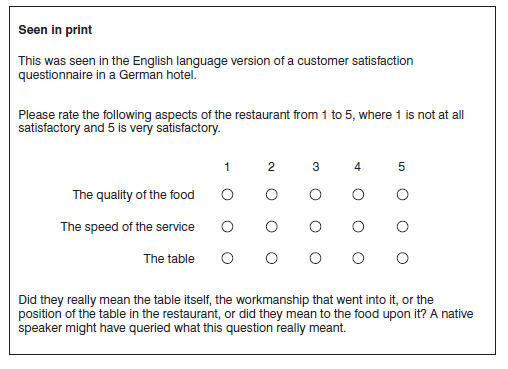Accurate translations are, of course, essential. But an accurate translation is not simply one that is literally accurate. Translations must be carried out sensitively so that meanings, shades of meaning and nuances are accurately retained.
Possibly the most difficult to translate are brand image and positioning statements and attitude dimensions. There may be fine but clear distinctions in one language that cannot be translated into another. In English there is a clear difference of understanding between ‘old-fashioned’ and ‘traditional’. In some languages this distinction cannot be made. Other words for which there may be no direct equivalent in certain languages include ‘arrogant’, ‘rigid’, ‘proud’ and ‘ordinary’. The word ‘warm’ is frequently used as a brand image descriptor in English, to describe the warmth and affection of the relationship between brand and consumer. However, it is not infrequently translated into other languages as something equivalent to ‘mildly hot’.
Even interviewer instructions can be ruined by a translator who is too literal, and inexperienced in the language of market research. The instruction to ‘Skip to Q5’ has been seen translated as ‘Run to Q5’, and ‘Probe fully’ turned into an instruction to poke the respondent with a stick.
For all of these reasons initial translations should be carried out by people who understand the research process and the importance of capturing the sentiment rather than a literal translation. Oppenheim (1992) quotes the case where a question asking whether a house had ‘running water’, although translated literally into other languages, was taken in some countries to mean having a stream or river running through the house. Wright and Crimp (2000) quote how ‘out of sight, out of mind’ became ‘invisible, insane’ in Mandarin Chinese.
1. Using native speakers
There are a number of different routes to achieving a good translation. Probably the most important step is for the first translation to be carried out by a native speaker of the language who also understands the research process. Native speakers are the most likely to understand the nuances of the language as they are understood by other native speakers. Many multinational research companies employ multilingual research executives or other members of staff who are from other countries.
However, native speakers living abroad may, depending on how long they have lived there, be out of touch with changes in the language as it is spoken locally. Subtle changes of meaning can occur with fashion or with a new usage. It is therefore important to have the translation checked by someone living in the country. The most likely candidate for this is someone in the agency that is going to be responsible for the fieldwork, provided that the person also has a good knowledge of the language in which the questionnaire was originally written.
A study is at a disadvantage if there is no fieldwork to be carried out locally, because it is being carried out online or by telephone from another country, as there is then a lack of opportunity for local input. For such studies, it is worth finding someone resident in the country who will check the translation for usage of current language. This is becoming an increasingly common issue, with the growing use of multi-country and multi-language web-based internet studies. The multinational research companies, with offices around the world on which they can call for this, have an advantage in this respect.

2. Using the client’s representative
If possible, the local representative of the client in each country should also check the translation. Local representatives may have had direct or indirect input to the questionnaire writer’s understanding of the structure of the market in the country. They should be aware of any variations in technical terminology relating to the local market that the research-led translator may not know about. It may also be important to get local representatives’ ‘buy-in’ to the questionnaire, if they are going to be responsible for implementing action that arises as a result of the research project. If they are not happy with the questionnaire, they may be less willing to implement the study’s findings.
3. Back-translation
Finally, the questionnaire should be back-translated into the original language. This can show up changes in meaning, although it has to be determined whether they arise from the original translation or from the back-translation.
The process described here is what should ideally happen. However, it is quite possible for some of these steps to be omitted, depending on the ability of the translators and whether the questionnaire has been used before.
It must not be overlooked that in some countries translation into a number of different languages and dialects will be required. Advice should be taken from the local client and research organizations as to how many and which languages are required. In a country such as India, for example, this can be a complex issue.
Source: Brace Ian (2018), Questionnaire Design: How to Plan, Structure and Write Survey Material for Effective Market Research, Kogan Page; 4th edition.

My brother recommended I might like this website.
He was totally right. This post actually made my day.
You can not believe just how a lot time I had spent for this
info! Thank you!